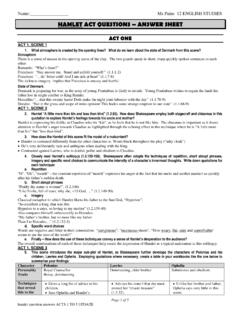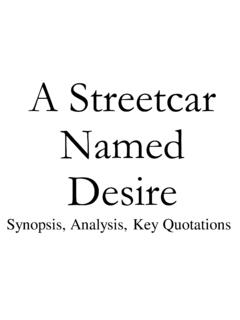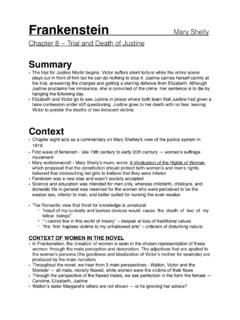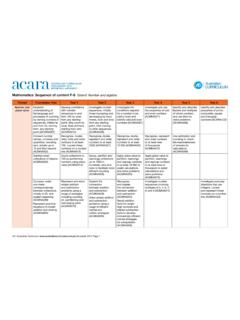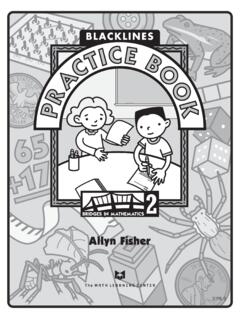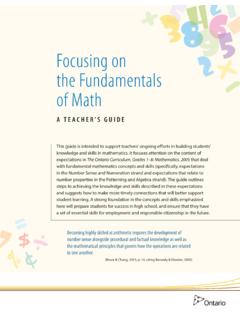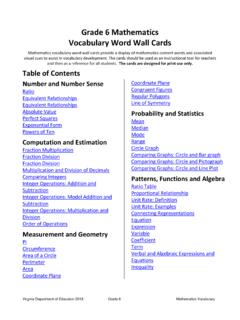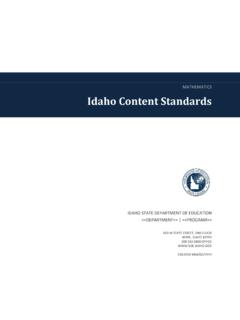Transcription of Patterns and Algebra F - cpb-ap-se2.wpmucdn.com
1 F. Series Student 3x +12=84. =20 4 +3x4=20. +3x4 =20 4. Patterns and Algebra +3x4 =20 4. +3x4=20 =20 4. +12=84 3x My name Copyright 2009 3P Learning. All rights reserved. First edition printed 2009 in Australia. A catalogue record for this book is available from 3P Learning Ltd. ISBN 978-1-921860-80-5. Ownership of content The materials in this resource, including without limitation all information, text, graphics, advertisements, names, logos and trade marks (Content) are protected by copyright, trade mark and other intellectual property laws unless expressly indicated otherwise. You must not modify, copy, reproduce, republish or distribute this Content in any way except as expressly provided for in these General Conditions or with our express prior written consent.
2 Copyright Copyright in this resource is owned or licensed by us. Other than for the purposes of, and subject to the conditions prescribed under, the Copyright Act 1968 (Cth) and similar legislation which applies in your location, and except as expressly authorised by these General Conditions, you may not in any form or by any means: adapt, reproduce, store, distribute, print, display, perform, publish or create derivative works from any part of this resource; or commercialise any information, products or services obtained from any part of this resource. Where copyright legislation in a location includes a remunerated scheme to permit educational institutions to copy or print any part of the resource, we will claim for remuneration under that scheme where worksheets are printed or photocopied by teachers for use by students, and where teachers direct students to print or photocopy worksheets for use by students at school.
3 A worksheet is a page of learning, designed for a student to write on using an ink pen or pencil. This may lead to an increase in the fees for educational institutions to participate in the relevant scheme. Published 3P Learning Ltd For more copies of this book, contact us at: Designed 3P Learning Ltd Although every precaution has been taken in the preparation of this book, the publisher and authors assume no responsibility for errors or omissions. Neither is any liability assumed for damages resulting from the use of this information contained herein. Series F Patterns and Algebra Contents Topic 1 Patterns and functions (pp. 1 12) Date completed recursive number patterns_____ / /.
4 Function number patterns_____ / /. matchstick patterns_____ / /. function machines_____ / /. function tables with addition and subtraction_____ / /. function tables with multiplication_____ / /. rows and columns apply_____ / /. pizza pizzazz solve_____ / /. Topic 2 Equations and equivalence (pp. 13 20). understanding equivalence_____ / /. using symbols_____ / /. keeping balance_____ / /. magician's hat trick solve_____ / /. Dhiffushi island currency solve_____ / /. Topic 3 Using equations (pp. 21 28). balance strategy using inverse operations_____ / /. word problems_____ / /. think of a number_____ / /. number tricks 1 solve_____ / /. number tricks 2 solve_____ / /.
5 Series Authors: Rachel Flenley Nicola Herringer Copyright . Patterns and functions recursive number Patterns Look around you, can you see a pattern? A pattern is an arrangement of shapes, numbers or objects formed according to a rule. Patterns are everywhere, you can find them in nature, art, music and even in dance! In this topic, we are looking at number Patterns . A number pattern is a sequence or list of numbers that is formed according to a rule. Number Patterns can use any of the four operations (+, , , ) or even a combination. In the example below, if we follow this instruction: starting at 1 add 5 each time we get this number pattern: 1 6 11 16 21.
6 +5 +5 +5 +5. 1 Write the next 3 numbers in each sequence by following the rule: a Rule: add 6 5 11 17 . b Rule: subtract 10 100 90 80 . c Rule: multiply by 2 2 4 8 . 2 Figure out the missing numbers in each pattern and write the rule. Circle the ascending Patterns . a 14 21 35 42 b 17 37 57 c 75 30 15. Rule _____ Rule _____ Rule _____. d 16 24 40 e 63 54 36 27 f 63 56 42 35. Rule _____ Rule _____ Rule _____. 3 Complete these grid Patterns . Look closely at the numbers in the grid and follow the Patterns . a b c 66 3. 32 76 17. 40 42 84 23 25. 50 52 96. Patterns and Algebra Copyright 3P Learning F 1 1. SERIES TOPIC. Patterns and functions recursive number Patterns Some number Patterns can be formed with 2 operations each time.
7 For example: 2 2+3 7 2+3 17 2+3 37. The rule is multiply by 2 and add 3 each time. 4 With these number Patterns , write the rule as 2 operations in the diamond shapes and describe it underneath. a 1 2+ 4 10 22. The rule is _____. b 2 3+ 7 22 67. The rule is _____. 5 Lena and Max were asked to show a number pattern for different rules. Check each sequence and put a circle around any errors. You may use a calculator. a Start at 2, add 1 and multiply by 2. Lena 2 6 14 30 62 126 254 510 1022. b Start at 3, add 1 and multiply by 2. Max 3 8 18 38 78 158 320 640 1280. 6 Look at each pattern of shapes and see if you can predict the following: a 1 2 3 4 5 6 7 8 9 10.
8 What will shape number 20 look like? Draw it here: What will shape number 33 look like? Draw it here: b 1 2 3 4 5 6 7 8 9 10. What will shape number 15 look like? Draw it here: What will shape number 26 look like? Draw it here: 2 F 1 Patterns and Algebra Copyright 3P Learning SERIES TOPIC. Patterns and functions function number Patterns There are 2 different types of rules that a number pattern can be based upon: 1 A recursive rule used to continue the sequence by doing something to the number before it. 2 A function rule used to predict any number by applying the rule to the position of the number. A function rule is a rule based on the position of a number.
9 Consider this. Lucia was given this number pattern: 5 10 15 20 25. Her teacher asked her to work out what the 20th number would be without continuing the sequence. Lucia used a table to work out the rule between the position of a number and the number in the pattern. She worked out the rule to be 5. Position of number 1 2 3 4 5 20. Function rule 5 5 5 5 5 5. Number pattern 5 10 15 20 25 100. So, following the rule based on the position of a number, the 20th number is 100. This is a function rule. 1 Use the function rule and then apply the rule to position 20. a Position of number 1 2 3 4 5 20. Function rule Number pattern 6 12 18 24 30. b Position of number 1 2 3 4 5 20.
10 Function rule HINT: In the last pattern, Number pattern 4 8 12 16 20 the rule has 2 operations. c Position of number 1 2 3 4 5 20. Function rule Number pattern 8 16 24 32 40. d Position of number 1 2 3 4 5 20. Function rule 4+. Number pattern 7 11 15 19 23. Patterns and Algebra Copyright 3P Learning F 1 3. SERIES TOPIC. Patterns and functions function number Patterns Function rules with 2 operations are easy to work out when we look at how they are linked to the multiplication tables. Position of number 1 2 3 4 5. 2 times table + 3 2+3 4+3 6+3 8+3 10 + 3. Number pattern 5 7 9 11 13. Function rule Multiply by 2 and then add 3. This table shows that the number pattern is the same as the 2 times table with 3 added to each answer.

